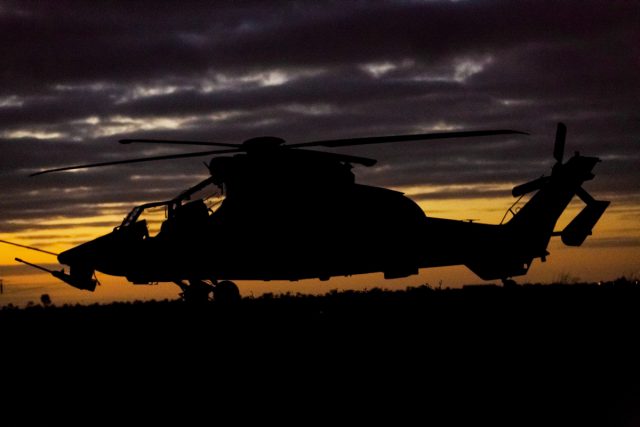
In 2011 the ADF took delivery of 22 Eurocopter ‘Aussie Tiger’ armed reconnaissance helicopters (ARH). Since then, the project has had a troubled history: the ANAO released a fairly scathing report in 2016, and more recently the ANAO’s 2017–18 Major Projects Report highlighted some continuing problems.
The Tiger’s future seems sealed. Both the 2016 Defence White Paper and its accompanying Integrated Investment Program declared that the Aussie Tiger will be replaced with a future ‘armed aerial reconnaissance capability from the mid-2020s’. The white paper’s judgement suggests the project has been a failure.
However, it’s important to be balanced in considering the platform, rather than dismissing it as an outright failure. According to the ANAO’s 2017–18 report, of the nine caveats identified in 2016, two have been resolved. The platform’s electronic warfare self-protection system now provides satisfactory performance, and the identification friend or foe system now works effectively. Two out of nine doesn’t sound like a great report card, but that’s not the end of the story.
Progress is being made towards integrating more capable AGM-114R Hellfire anti-tank guided missile systems, and the availability of spare parts and ammunition supplies is improving. Furthermore, ‘fly-away kits’ to support operational deployments are now available. Following a prolonged grounding during investigation into a German Tiger crash in Mali in 2017, the Aussie Tiger resumed flights last November.
New capabilities are being added to the platform as part of joint force modernisation. Those include precision laser-guided rockets, a ‘manned-unmanned teaming’ capability with the Army’s Shadow UAVs, ‘wet-wing’ combat refuelling with C-130J aircraft and, most significantly, initial flight trials on the RAN’s Canberra-class amphibious assault ships.
Army personnel who fly the aircraft have an overwhelmingly positive view of it. They note that it’s a highly agile and potent platform, with superior manoeuvrability to other, similar types of helicopter, which makes it easier to fly and to focus on mission tasks. They make clear that the platform has matured as a capability, and operators are overcoming earlier challenges. They argue that serious deficiencies such as availability and rate of effort are being addressed, and the absence of a tactical datalink is being rectified, though operating costs are yet to meet desired targets. They also raise the prospect of a capability assurance program that will maintain the Aussie Tiger as a useful capability through to its replacement in 2025, and also potentially provide upgrades to deal with issues that the ANAO currently lists as deficiencies.
This debate over upgrades versus deficiencies goes to the heart of the criticism of the Tiger as a developmental rather than a mature aircraft. Basing procurement decisions on an erroneous assumption of a mature capability, together with putting in place inadequate maintenance and support arrangements, acted to create the impression that the Aussie Tiger was underperforming and over budget. The failure wasn’t the aircraft’s, but that of the procurement process and decisions that were made under AIR 87 Phase 2.
In considering the potential replacement for the Aussie Tiger ARH in the mid-2020s, some hard realities have been recognised. Most importantly, Defence cannot again blithely take a contractor’s word that a platform is mature, as opposed to developmental. Instead, it must make a more hard-nosed assessment as to which platforms best suit Australia’s requirements, and which present the least risk. In that regard, three important lessons stand out rather starkly from the Aussie Tiger experience as we look forward to 2025.
Firstly, it’s more sensible to acquire military off-the-shelf platforms that are operationally mature than to gamble everything on an immature capability still under development. Secondly, it’s wise to pick a capability with a fully established global support and maintenance network that enjoys a wide range of users, as opposed to an ‘orphan capability’ where support and maintenance is limited and depends on distant service providers. Thirdly, any platform must be fully interoperable with existing capabilities. In particular, it must have common datalinks as a standard feature.
The inability of the Aussie Tiger to meet operational readiness remains a major problem. The objective of reaching 6,000 flight hours per year won’t be met anytime soon, and the 2017–18 ANAO report suggests there were only 4,800 hours during FY 2016–17. The Army and Airbus Australia continue efforts to remediate this problem, but it’s clear that choosing a more mature platform with an established supply chain would have meant that the ADF wouldn’t ever have been confronted by poor operational readiness.
But if these problems could be solved, why not hang onto the Tiger for longer? The platform would be only a little over a decade old in 2025, and would have been upgraded to avoid obsolescence at a cost of A$500–750 million. That’s a considerable sum of money to spend on a platform only to then dispose of it.
This suggests that one option would be to extend the Aussie Tiger through to the early 2030s and ‘catch the wave’ generated by the US Future Vertical Lift program (FVL) through direct Australian involvement in that project, in a manner similar to Australian participation in the F-35 Joint Strike Fighter project. Alternatively, government might replace the Tiger in the mid-2020s, or sooner, with an ‘interim capability’ akin to the RAAF’s acquisition of F/A-18F Super Hornets. This could mitigate the potential risk posed by additional problems with the Aussie Tiger, and also act as insurance against the FVL being delayed. It would also enhance capability more rapidly, depending on what platform was acquired.
Which option government chooses in coming years will depend on what tasks emerge as the most likely for the ADF in a more contested and uncertain operational environment. Considering army aviation’s likely role and how that will influence prospective capability choices will be explored in the next article.

